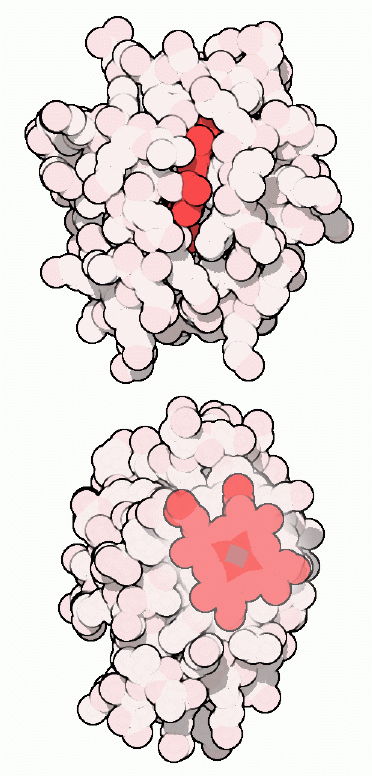|
Inhaltsübersicht | Nanomaschinen | Moleküle | Programme | Kurse | Fun | Links |
||
| > |
Cytochrome C

Electricity is a common phenomenon in our modern world, powering everything from the lights in your room to the computer in front of you. Electricity is the flow of electrons within a conductive material, such as metal wires. These electrons flow in bulk, meandering from atom to atom along the wire. Cells also use electricity to power many processes, but the electrons move in a very different way. The electrons do not flow smoothly along a cell-sized wire. Instead, electrons are transported one at a time, jumping from protein to protein. In this way, the electrons may be picked up from one particular place and delivered exactly where they are needed.
Delivering Electrons
Cytochrome c, shown here from PDB entry 3cyt, is a carrier of electrons. Like many proteins that carry electrons, it contains a special prosthetic group that handles the slippery electrons. Cytochrome c contains a heme group with an iron ion gripped tightly inside, colored red here. The iron ion readily accepts and releases an electron. The surrounding protein creates the perfect environment for the electron, tuning how tightly it is held. As shown on the next page, the protein also determines where cytochrome c fits into the overall cellular electronic circuit.A Venerable Family
Cytochrome c is an ancient protein, developed early in the evolution of life. Since this essential protein performs a key step in the production of cellular energy, it has changed little in millions of years. So, you can look into yeast cells or plant cells or our own cells and find a very similar form of cytochrome c. If you look around the PDB, however, you can find a diverse collection of other electron carrier molecules. There are many variations on cytochrome c, which use heme and iron to carry electrons, but change the protein surrounding them to perform different jobs. Other carriers use other prosthetic groups to carry electrons, such as clusters of iron and sulfur (such as ferredoxin), brilliant blue copper ions (such as azurin and plastocyanin) or more exotic metal ions. Like cytochrome c, each of these proteins is a single connection in a cellular electronic circuit, transferring electrons from one point to another.Next: Cellular Circuits
Last changed by: A.Honegger,